Report on Communication Strategies at The Sunburn Hotel, Australia
VerifiedAdded on 2022/11/07
|9
|2063
|136
Report
AI Summary
This report presents an analysis of communication strategies employed at The Sunburn Hotel in Melbourne, Australia, based on semi-structured interviews with hotel managers. The study explores key communication areas including intercultural communication, persuasion, negotiation, meetings, and conflict resolution within the context of a diverse workforce and international clientele. The findings highlight both effective communication practices and areas for improvement, such as enhancing intercultural understanding, refining negotiation tactics, and optimizing meeting effectiveness. The report concludes with recommendations for the hotel, suggesting training programs to enhance cross-cultural knowledge, promote a collaborative environment, and improve overall communication efficiency. These measures aim to support the hotel in maintaining high-quality service and managing workplace conflicts effectively, particularly during peak seasons.
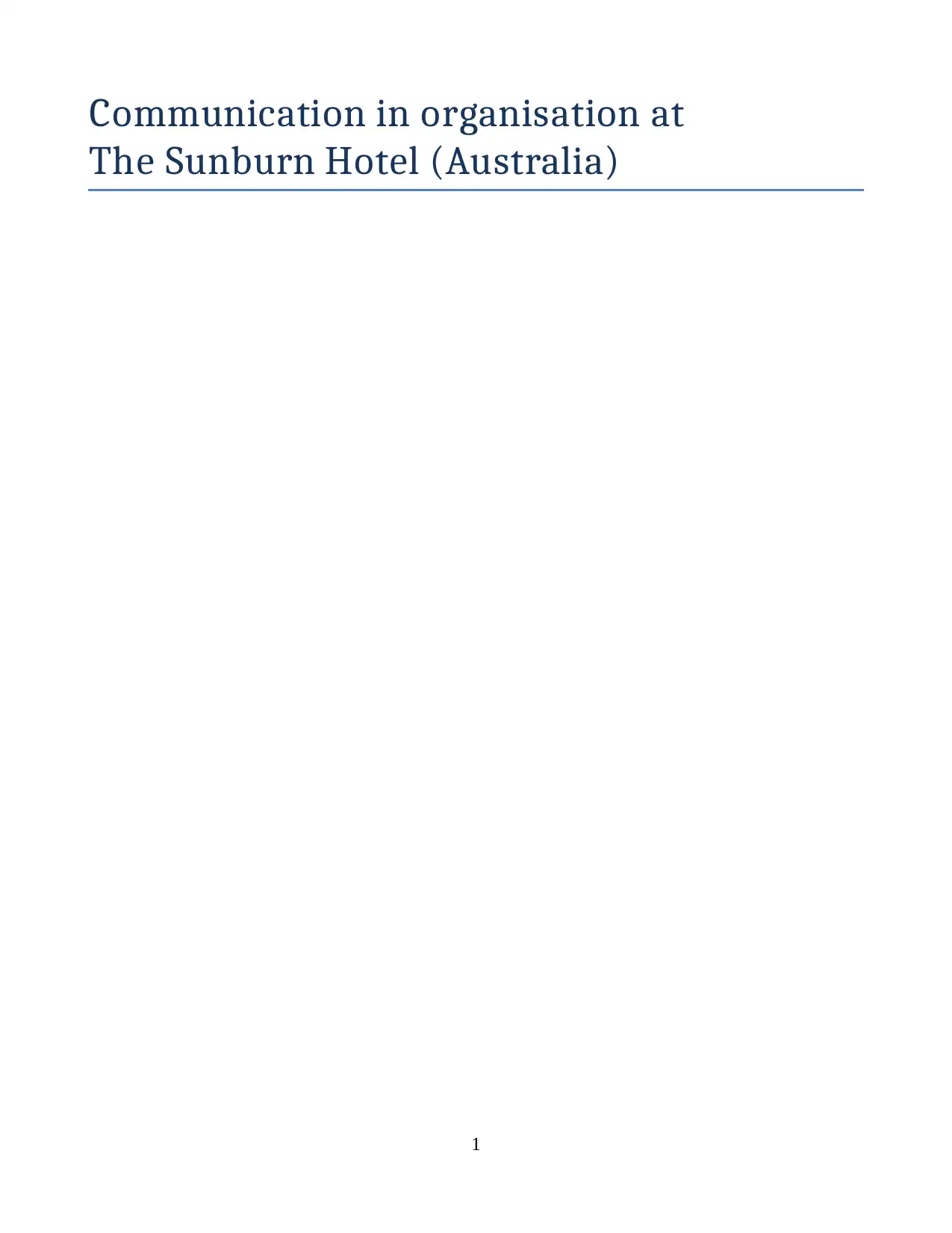
Communication in organisation at
The Sunburn Hotel (Australia)
1
The Sunburn Hotel (Australia)
1
Paraphrase This Document
Need a fresh take? Get an instant paraphrase of this document with our AI Paraphraser
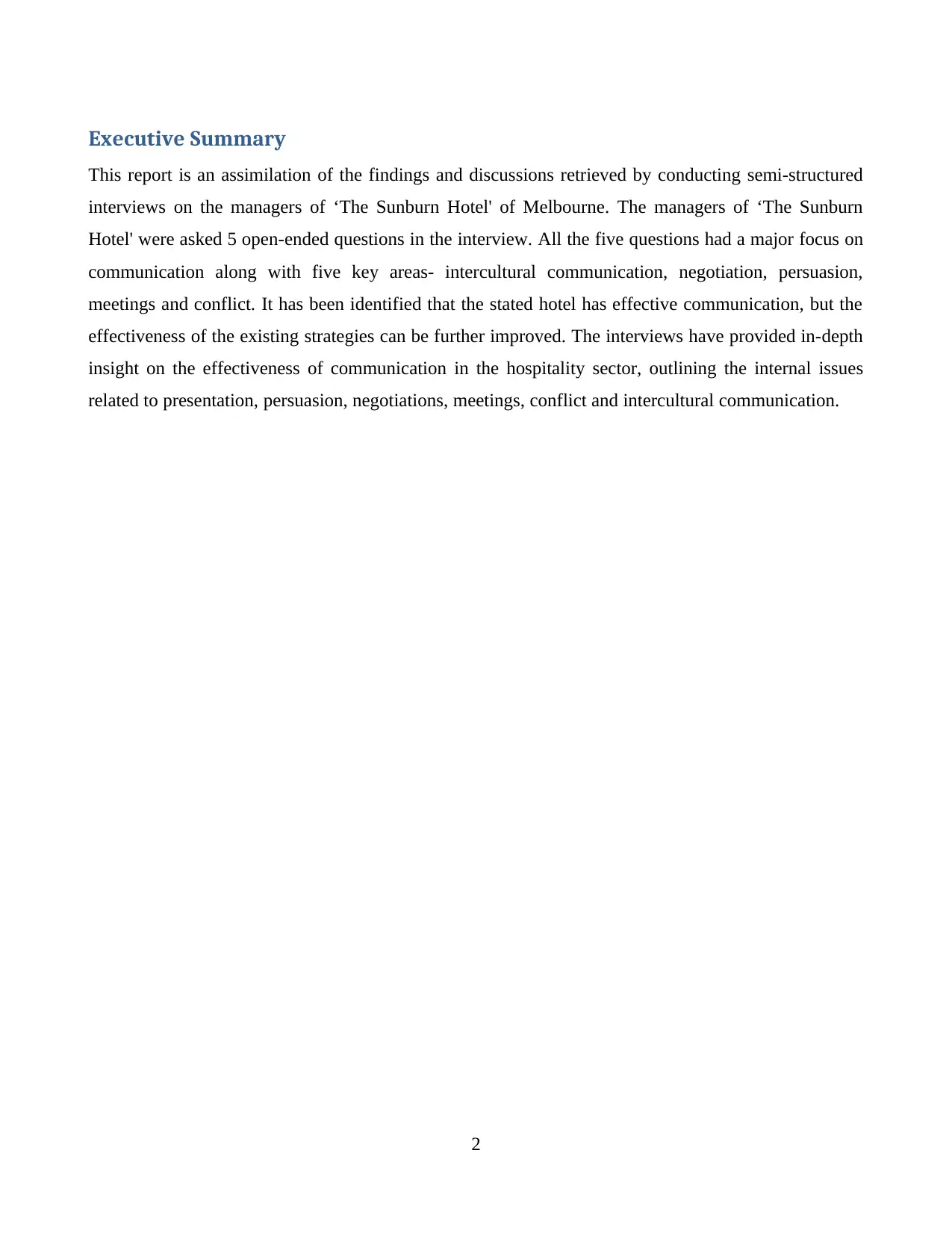
Executive Summary
This report is an assimilation of the findings and discussions retrieved by conducting semi-structured
interviews on the managers of ‘The Sunburn Hotel' of Melbourne. The managers of ‘The Sunburn
Hotel' were asked 5 open-ended questions in the interview. All the five questions had a major focus on
communication along with five key areas- intercultural communication, negotiation, persuasion,
meetings and conflict. It has been identified that the stated hotel has effective communication, but the
effectiveness of the existing strategies can be further improved. The interviews have provided in-depth
insight on the effectiveness of communication in the hospitality sector, outlining the internal issues
related to presentation, persuasion, negotiations, meetings, conflict and intercultural communication.
2
This report is an assimilation of the findings and discussions retrieved by conducting semi-structured
interviews on the managers of ‘The Sunburn Hotel' of Melbourne. The managers of ‘The Sunburn
Hotel' were asked 5 open-ended questions in the interview. All the five questions had a major focus on
communication along with five key areas- intercultural communication, negotiation, persuasion,
meetings and conflict. It has been identified that the stated hotel has effective communication, but the
effectiveness of the existing strategies can be further improved. The interviews have provided in-depth
insight on the effectiveness of communication in the hospitality sector, outlining the internal issues
related to presentation, persuasion, negotiations, meetings, conflict and intercultural communication.
2
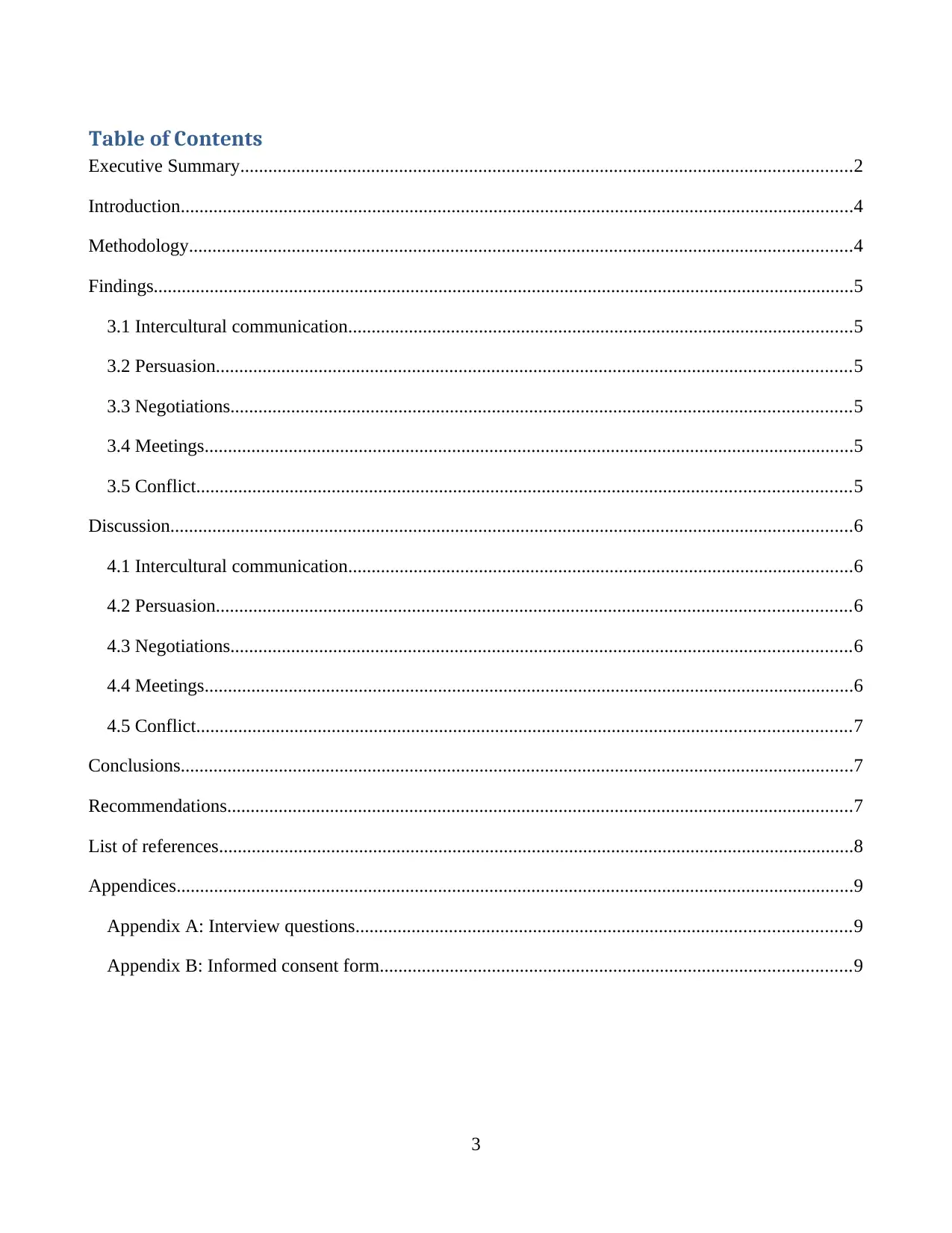
Table of Contents
Executive Summary...................................................................................................................................2
Introduction................................................................................................................................................4
Methodology..............................................................................................................................................4
Findings......................................................................................................................................................5
3.1 Intercultural communication............................................................................................................5
3.2 Persuasion........................................................................................................................................5
3.3 Negotiations.....................................................................................................................................5
3.4 Meetings...........................................................................................................................................5
3.5 Conflict............................................................................................................................................5
Discussion..................................................................................................................................................6
4.1 Intercultural communication............................................................................................................6
4.2 Persuasion........................................................................................................................................6
4.3 Negotiations.....................................................................................................................................6
4.4 Meetings...........................................................................................................................................6
4.5 Conflict............................................................................................................................................7
Conclusions................................................................................................................................................7
Recommendations......................................................................................................................................7
List of references........................................................................................................................................8
Appendices.................................................................................................................................................9
Appendix A: Interview questions..........................................................................................................9
Appendix B: Informed consent form.....................................................................................................9
3
Executive Summary...................................................................................................................................2
Introduction................................................................................................................................................4
Methodology..............................................................................................................................................4
Findings......................................................................................................................................................5
3.1 Intercultural communication............................................................................................................5
3.2 Persuasion........................................................................................................................................5
3.3 Negotiations.....................................................................................................................................5
3.4 Meetings...........................................................................................................................................5
3.5 Conflict............................................................................................................................................5
Discussion..................................................................................................................................................6
4.1 Intercultural communication............................................................................................................6
4.2 Persuasion........................................................................................................................................6
4.3 Negotiations.....................................................................................................................................6
4.4 Meetings...........................................................................................................................................6
4.5 Conflict............................................................................................................................................7
Conclusions................................................................................................................................................7
Recommendations......................................................................................................................................7
List of references........................................................................................................................................8
Appendices.................................................................................................................................................9
Appendix A: Interview questions..........................................................................................................9
Appendix B: Informed consent form.....................................................................................................9
3
⊘ This is a preview!⊘
Do you want full access?
Subscribe today to unlock all pages.

Trusted by 1+ million students worldwide
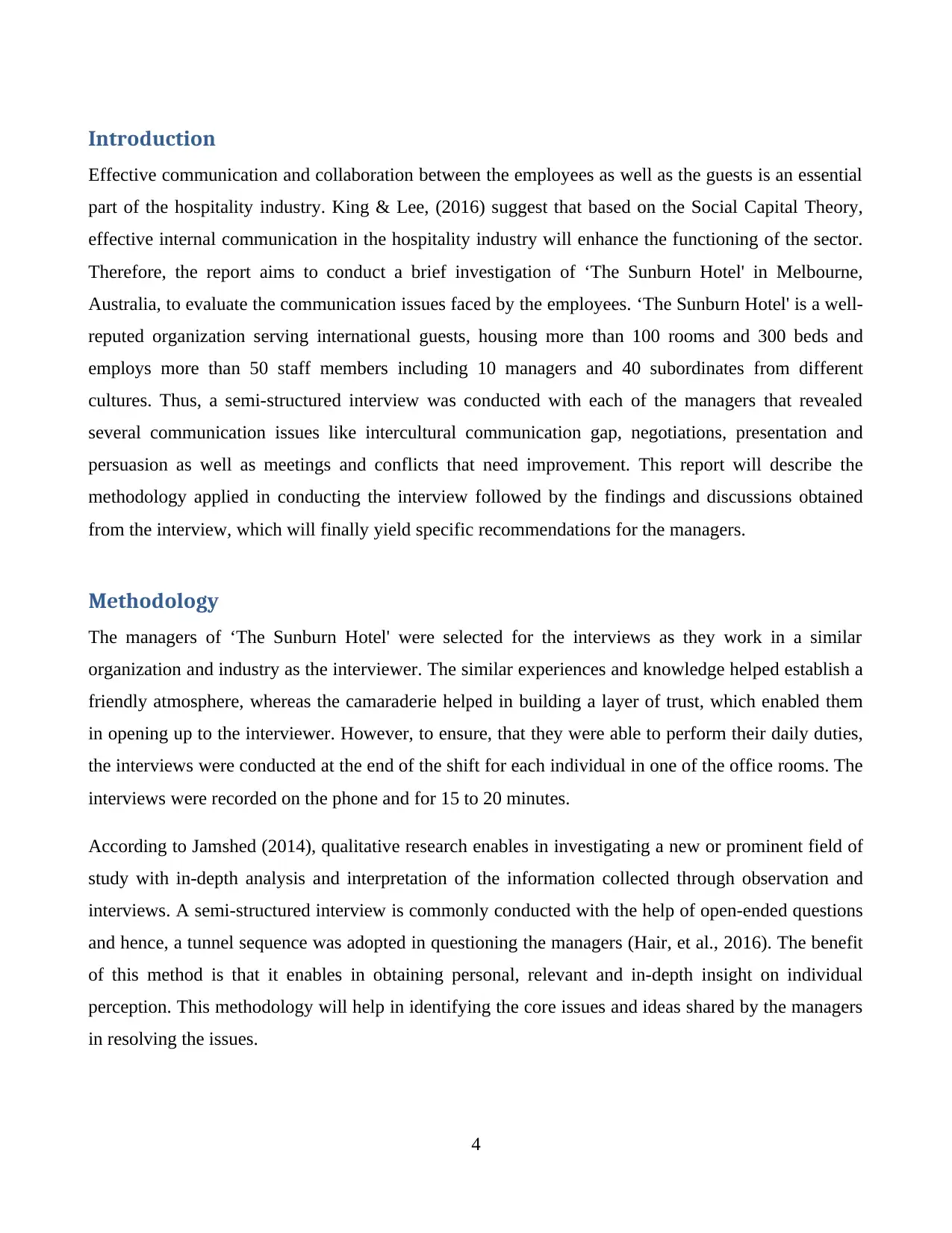
Introduction
Effective communication and collaboration between the employees as well as the guests is an essential
part of the hospitality industry. King & Lee, (2016) suggest that based on the Social Capital Theory,
effective internal communication in the hospitality industry will enhance the functioning of the sector.
Therefore, the report aims to conduct a brief investigation of ‘The Sunburn Hotel' in Melbourne,
Australia, to evaluate the communication issues faced by the employees. ‘The Sunburn Hotel' is a well-
reputed organization serving international guests, housing more than 100 rooms and 300 beds and
employs more than 50 staff members including 10 managers and 40 subordinates from different
cultures. Thus, a semi-structured interview was conducted with each of the managers that revealed
several communication issues like intercultural communication gap, negotiations, presentation and
persuasion as well as meetings and conflicts that need improvement. This report will describe the
methodology applied in conducting the interview followed by the findings and discussions obtained
from the interview, which will finally yield specific recommendations for the managers.
Methodology
The managers of ‘The Sunburn Hotel' were selected for the interviews as they work in a similar
organization and industry as the interviewer. The similar experiences and knowledge helped establish a
friendly atmosphere, whereas the camaraderie helped in building a layer of trust, which enabled them
in opening up to the interviewer. However, to ensure, that they were able to perform their daily duties,
the interviews were conducted at the end of the shift for each individual in one of the office rooms. The
interviews were recorded on the phone and for 15 to 20 minutes.
According to Jamshed (2014), qualitative research enables in investigating a new or prominent field of
study with in-depth analysis and interpretation of the information collected through observation and
interviews. A semi-structured interview is commonly conducted with the help of open-ended questions
and hence, a tunnel sequence was adopted in questioning the managers (Hair, et al., 2016). The benefit
of this method is that it enables in obtaining personal, relevant and in-depth insight on individual
perception. This methodology will help in identifying the core issues and ideas shared by the managers
in resolving the issues.
4
Effective communication and collaboration between the employees as well as the guests is an essential
part of the hospitality industry. King & Lee, (2016) suggest that based on the Social Capital Theory,
effective internal communication in the hospitality industry will enhance the functioning of the sector.
Therefore, the report aims to conduct a brief investigation of ‘The Sunburn Hotel' in Melbourne,
Australia, to evaluate the communication issues faced by the employees. ‘The Sunburn Hotel' is a well-
reputed organization serving international guests, housing more than 100 rooms and 300 beds and
employs more than 50 staff members including 10 managers and 40 subordinates from different
cultures. Thus, a semi-structured interview was conducted with each of the managers that revealed
several communication issues like intercultural communication gap, negotiations, presentation and
persuasion as well as meetings and conflicts that need improvement. This report will describe the
methodology applied in conducting the interview followed by the findings and discussions obtained
from the interview, which will finally yield specific recommendations for the managers.
Methodology
The managers of ‘The Sunburn Hotel' were selected for the interviews as they work in a similar
organization and industry as the interviewer. The similar experiences and knowledge helped establish a
friendly atmosphere, whereas the camaraderie helped in building a layer of trust, which enabled them
in opening up to the interviewer. However, to ensure, that they were able to perform their daily duties,
the interviews were conducted at the end of the shift for each individual in one of the office rooms. The
interviews were recorded on the phone and for 15 to 20 minutes.
According to Jamshed (2014), qualitative research enables in investigating a new or prominent field of
study with in-depth analysis and interpretation of the information collected through observation and
interviews. A semi-structured interview is commonly conducted with the help of open-ended questions
and hence, a tunnel sequence was adopted in questioning the managers (Hair, et al., 2016). The benefit
of this method is that it enables in obtaining personal, relevant and in-depth insight on individual
perception. This methodology will help in identifying the core issues and ideas shared by the managers
in resolving the issues.
4
Paraphrase This Document
Need a fresh take? Get an instant paraphrase of this document with our AI Paraphraser
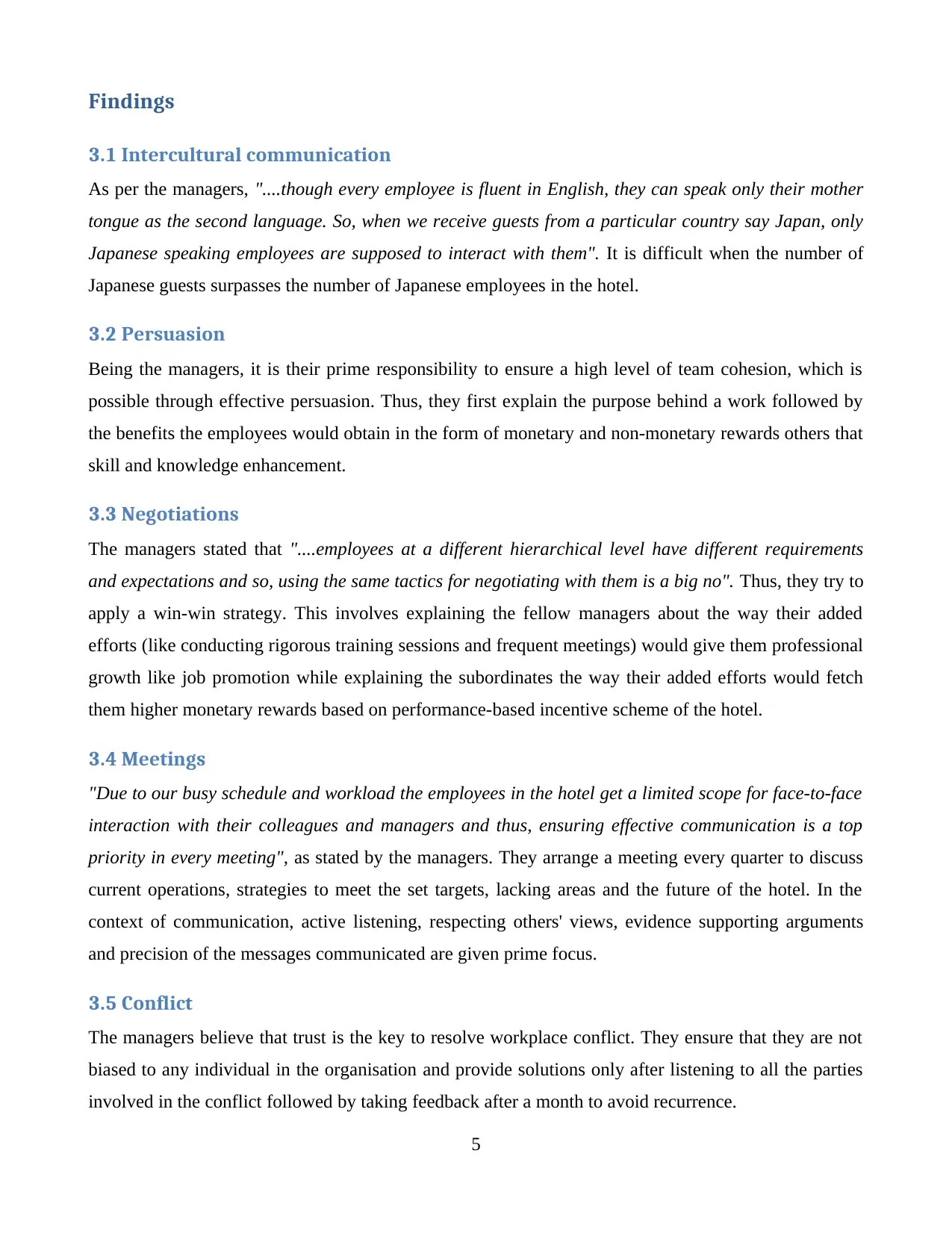
Findings
3.1 Intercultural communication
As per the managers, "....though every employee is fluent in English, they can speak only their mother
tongue as the second language. So, when we receive guests from a particular country say Japan, only
Japanese speaking employees are supposed to interact with them". It is difficult when the number of
Japanese guests surpasses the number of Japanese employees in the hotel.
3.2 Persuasion
Being the managers, it is their prime responsibility to ensure a high level of team cohesion, which is
possible through effective persuasion. Thus, they first explain the purpose behind a work followed by
the benefits the employees would obtain in the form of monetary and non-monetary rewards others that
skill and knowledge enhancement.
3.3 Negotiations
The managers stated that "....employees at a different hierarchical level have different requirements
and expectations and so, using the same tactics for negotiating with them is a big no". Thus, they try to
apply a win-win strategy. This involves explaining the fellow managers about the way their added
efforts (like conducting rigorous training sessions and frequent meetings) would give them professional
growth like job promotion while explaining the subordinates the way their added efforts would fetch
them higher monetary rewards based on performance-based incentive scheme of the hotel.
3.4 Meetings
"Due to our busy schedule and workload the employees in the hotel get a limited scope for face-to-face
interaction with their colleagues and managers and thus, ensuring effective communication is a top
priority in every meeting", as stated by the managers. They arrange a meeting every quarter to discuss
current operations, strategies to meet the set targets, lacking areas and the future of the hotel. In the
context of communication, active listening, respecting others' views, evidence supporting arguments
and precision of the messages communicated are given prime focus.
3.5 Conflict
The managers believe that trust is the key to resolve workplace conflict. They ensure that they are not
biased to any individual in the organisation and provide solutions only after listening to all the parties
involved in the conflict followed by taking feedback after a month to avoid recurrence.
5
3.1 Intercultural communication
As per the managers, "....though every employee is fluent in English, they can speak only their mother
tongue as the second language. So, when we receive guests from a particular country say Japan, only
Japanese speaking employees are supposed to interact with them". It is difficult when the number of
Japanese guests surpasses the number of Japanese employees in the hotel.
3.2 Persuasion
Being the managers, it is their prime responsibility to ensure a high level of team cohesion, which is
possible through effective persuasion. Thus, they first explain the purpose behind a work followed by
the benefits the employees would obtain in the form of monetary and non-monetary rewards others that
skill and knowledge enhancement.
3.3 Negotiations
The managers stated that "....employees at a different hierarchical level have different requirements
and expectations and so, using the same tactics for negotiating with them is a big no". Thus, they try to
apply a win-win strategy. This involves explaining the fellow managers about the way their added
efforts (like conducting rigorous training sessions and frequent meetings) would give them professional
growth like job promotion while explaining the subordinates the way their added efforts would fetch
them higher monetary rewards based on performance-based incentive scheme of the hotel.
3.4 Meetings
"Due to our busy schedule and workload the employees in the hotel get a limited scope for face-to-face
interaction with their colleagues and managers and thus, ensuring effective communication is a top
priority in every meeting", as stated by the managers. They arrange a meeting every quarter to discuss
current operations, strategies to meet the set targets, lacking areas and the future of the hotel. In the
context of communication, active listening, respecting others' views, evidence supporting arguments
and precision of the messages communicated are given prime focus.
3.5 Conflict
The managers believe that trust is the key to resolve workplace conflict. They ensure that they are not
biased to any individual in the organisation and provide solutions only after listening to all the parties
involved in the conflict followed by taking feedback after a month to avoid recurrence.
5
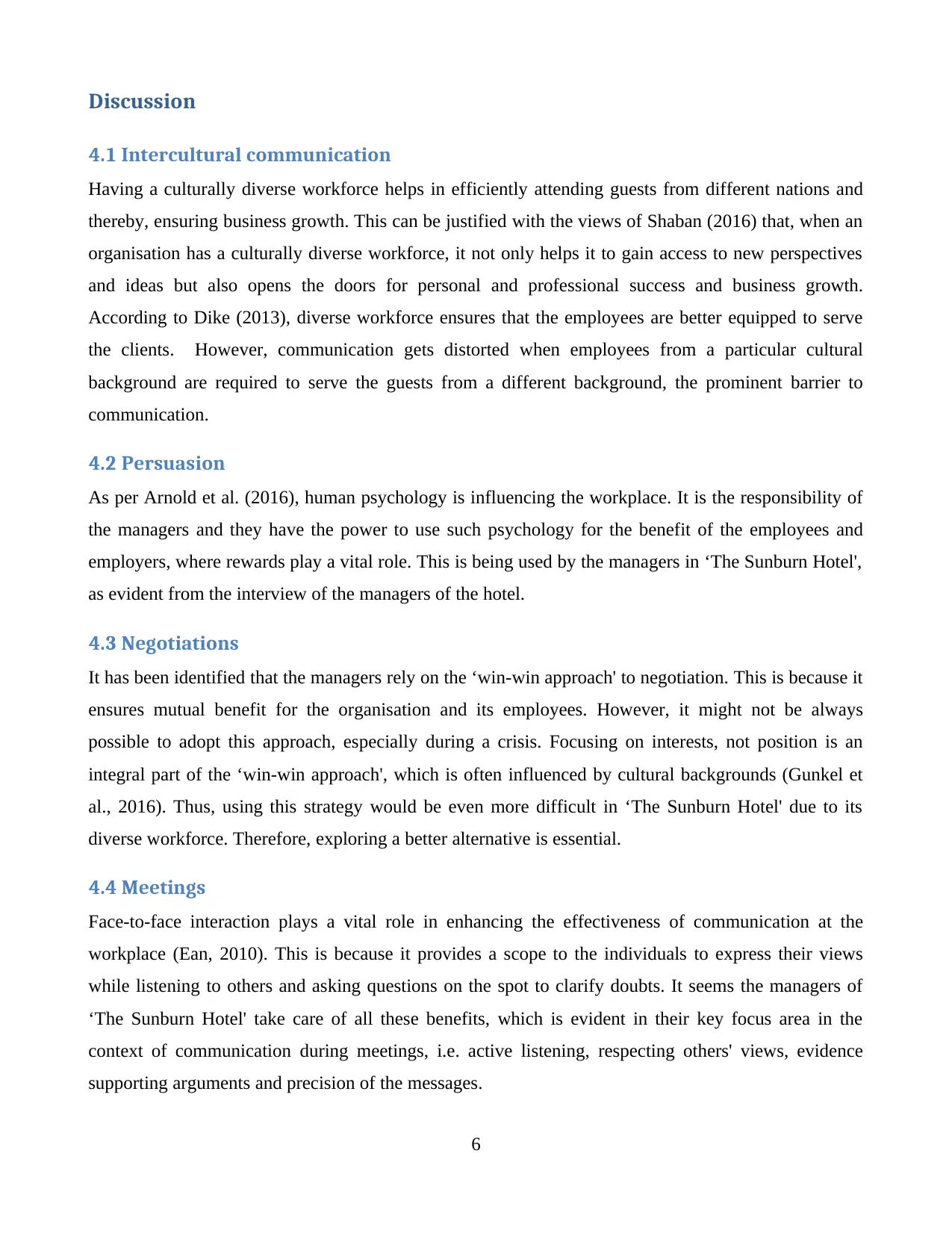
Discussion
4.1 Intercultural communication
Having a culturally diverse workforce helps in efficiently attending guests from different nations and
thereby, ensuring business growth. This can be justified with the views of Shaban (2016) that, when an
organisation has a culturally diverse workforce, it not only helps it to gain access to new perspectives
and ideas but also opens the doors for personal and professional success and business growth.
According to Dike (2013), diverse workforce ensures that the employees are better equipped to serve
the clients. However, communication gets distorted when employees from a particular cultural
background are required to serve the guests from a different background, the prominent barrier to
communication.
4.2 Persuasion
As per Arnold et al. (2016), human psychology is influencing the workplace. It is the responsibility of
the managers and they have the power to use such psychology for the benefit of the employees and
employers, where rewards play a vital role. This is being used by the managers in ‘The Sunburn Hotel',
as evident from the interview of the managers of the hotel.
4.3 Negotiations
It has been identified that the managers rely on the ‘win-win approach' to negotiation. This is because it
ensures mutual benefit for the organisation and its employees. However, it might not be always
possible to adopt this approach, especially during a crisis. Focusing on interests, not position is an
integral part of the ‘win-win approach', which is often influenced by cultural backgrounds (Gunkel et
al., 2016). Thus, using this strategy would be even more difficult in ‘The Sunburn Hotel' due to its
diverse workforce. Therefore, exploring a better alternative is essential.
4.4 Meetings
Face-to-face interaction plays a vital role in enhancing the effectiveness of communication at the
workplace (Ean, 2010). This is because it provides a scope to the individuals to express their views
while listening to others and asking questions on the spot to clarify doubts. It seems the managers of
‘The Sunburn Hotel' take care of all these benefits, which is evident in their key focus area in the
context of communication during meetings, i.e. active listening, respecting others' views, evidence
supporting arguments and precision of the messages.
6
4.1 Intercultural communication
Having a culturally diverse workforce helps in efficiently attending guests from different nations and
thereby, ensuring business growth. This can be justified with the views of Shaban (2016) that, when an
organisation has a culturally diverse workforce, it not only helps it to gain access to new perspectives
and ideas but also opens the doors for personal and professional success and business growth.
According to Dike (2013), diverse workforce ensures that the employees are better equipped to serve
the clients. However, communication gets distorted when employees from a particular cultural
background are required to serve the guests from a different background, the prominent barrier to
communication.
4.2 Persuasion
As per Arnold et al. (2016), human psychology is influencing the workplace. It is the responsibility of
the managers and they have the power to use such psychology for the benefit of the employees and
employers, where rewards play a vital role. This is being used by the managers in ‘The Sunburn Hotel',
as evident from the interview of the managers of the hotel.
4.3 Negotiations
It has been identified that the managers rely on the ‘win-win approach' to negotiation. This is because it
ensures mutual benefit for the organisation and its employees. However, it might not be always
possible to adopt this approach, especially during a crisis. Focusing on interests, not position is an
integral part of the ‘win-win approach', which is often influenced by cultural backgrounds (Gunkel et
al., 2016). Thus, using this strategy would be even more difficult in ‘The Sunburn Hotel' due to its
diverse workforce. Therefore, exploring a better alternative is essential.
4.4 Meetings
Face-to-face interaction plays a vital role in enhancing the effectiveness of communication at the
workplace (Ean, 2010). This is because it provides a scope to the individuals to express their views
while listening to others and asking questions on the spot to clarify doubts. It seems the managers of
‘The Sunburn Hotel' take care of all these benefits, which is evident in their key focus area in the
context of communication during meetings, i.e. active listening, respecting others' views, evidence
supporting arguments and precision of the messages.
6
⊘ This is a preview!⊘
Do you want full access?
Subscribe today to unlock all pages.

Trusted by 1+ million students worldwide
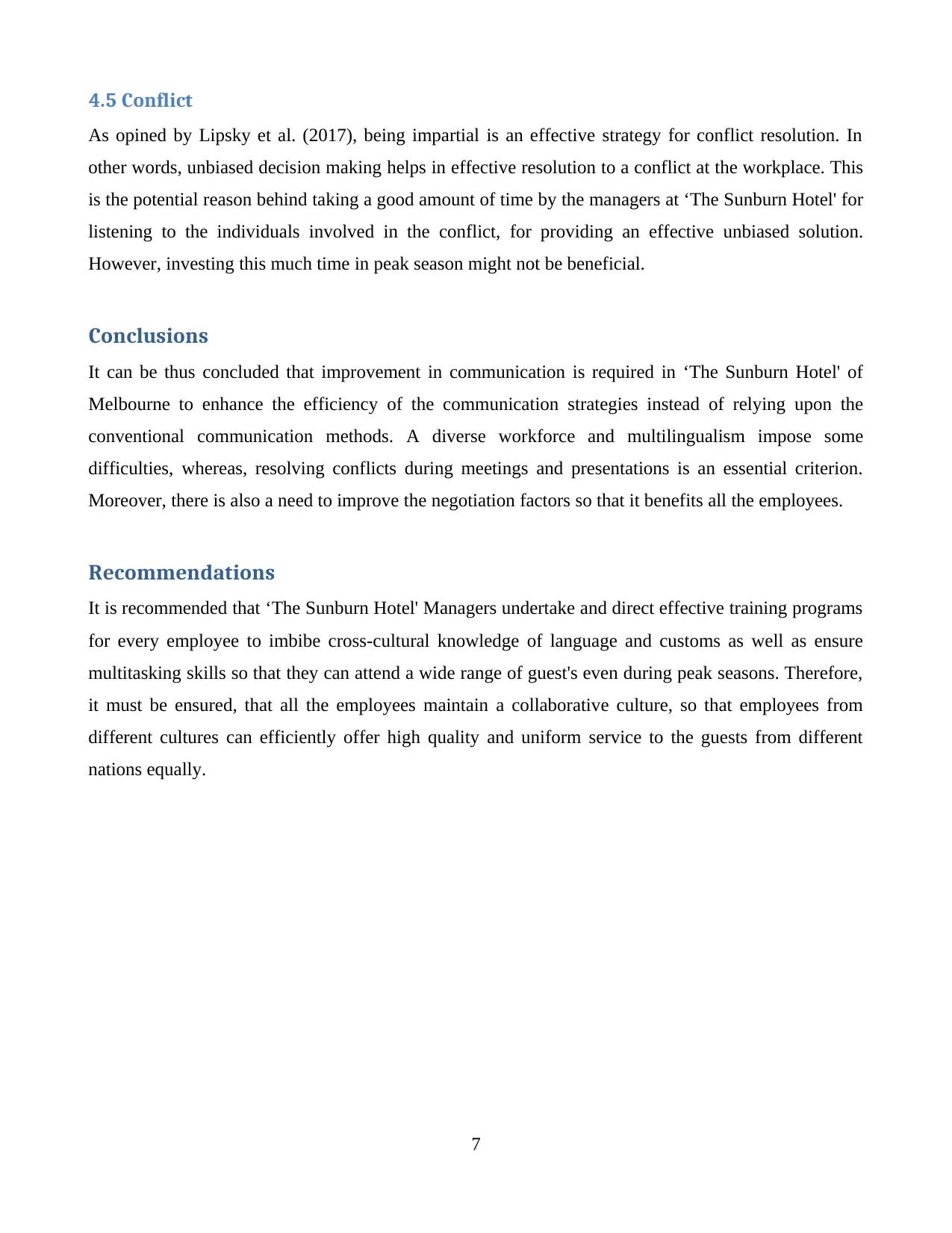
4.5 Conflict
As opined by Lipsky et al. (2017), being impartial is an effective strategy for conflict resolution. In
other words, unbiased decision making helps in effective resolution to a conflict at the workplace. This
is the potential reason behind taking a good amount of time by the managers at ‘The Sunburn Hotel' for
listening to the individuals involved in the conflict, for providing an effective unbiased solution.
However, investing this much time in peak season might not be beneficial.
Conclusions
It can be thus concluded that improvement in communication is required in ‘The Sunburn Hotel' of
Melbourne to enhance the efficiency of the communication strategies instead of relying upon the
conventional communication methods. A diverse workforce and multilingualism impose some
difficulties, whereas, resolving conflicts during meetings and presentations is an essential criterion.
Moreover, there is also a need to improve the negotiation factors so that it benefits all the employees.
Recommendations
It is recommended that ‘The Sunburn Hotel' Managers undertake and direct effective training programs
for every employee to imbibe cross-cultural knowledge of language and customs as well as ensure
multitasking skills so that they can attend a wide range of guest's even during peak seasons. Therefore,
it must be ensured, that all the employees maintain a collaborative culture, so that employees from
different cultures can efficiently offer high quality and uniform service to the guests from different
nations equally.
7
As opined by Lipsky et al. (2017), being impartial is an effective strategy for conflict resolution. In
other words, unbiased decision making helps in effective resolution to a conflict at the workplace. This
is the potential reason behind taking a good amount of time by the managers at ‘The Sunburn Hotel' for
listening to the individuals involved in the conflict, for providing an effective unbiased solution.
However, investing this much time in peak season might not be beneficial.
Conclusions
It can be thus concluded that improvement in communication is required in ‘The Sunburn Hotel' of
Melbourne to enhance the efficiency of the communication strategies instead of relying upon the
conventional communication methods. A diverse workforce and multilingualism impose some
difficulties, whereas, resolving conflicts during meetings and presentations is an essential criterion.
Moreover, there is also a need to improve the negotiation factors so that it benefits all the employees.
Recommendations
It is recommended that ‘The Sunburn Hotel' Managers undertake and direct effective training programs
for every employee to imbibe cross-cultural knowledge of language and customs as well as ensure
multitasking skills so that they can attend a wide range of guest's even during peak seasons. Therefore,
it must be ensured, that all the employees maintain a collaborative culture, so that employees from
different cultures can efficiently offer high quality and uniform service to the guests from different
nations equally.
7
Paraphrase This Document
Need a fresh take? Get an instant paraphrase of this document with our AI Paraphraser
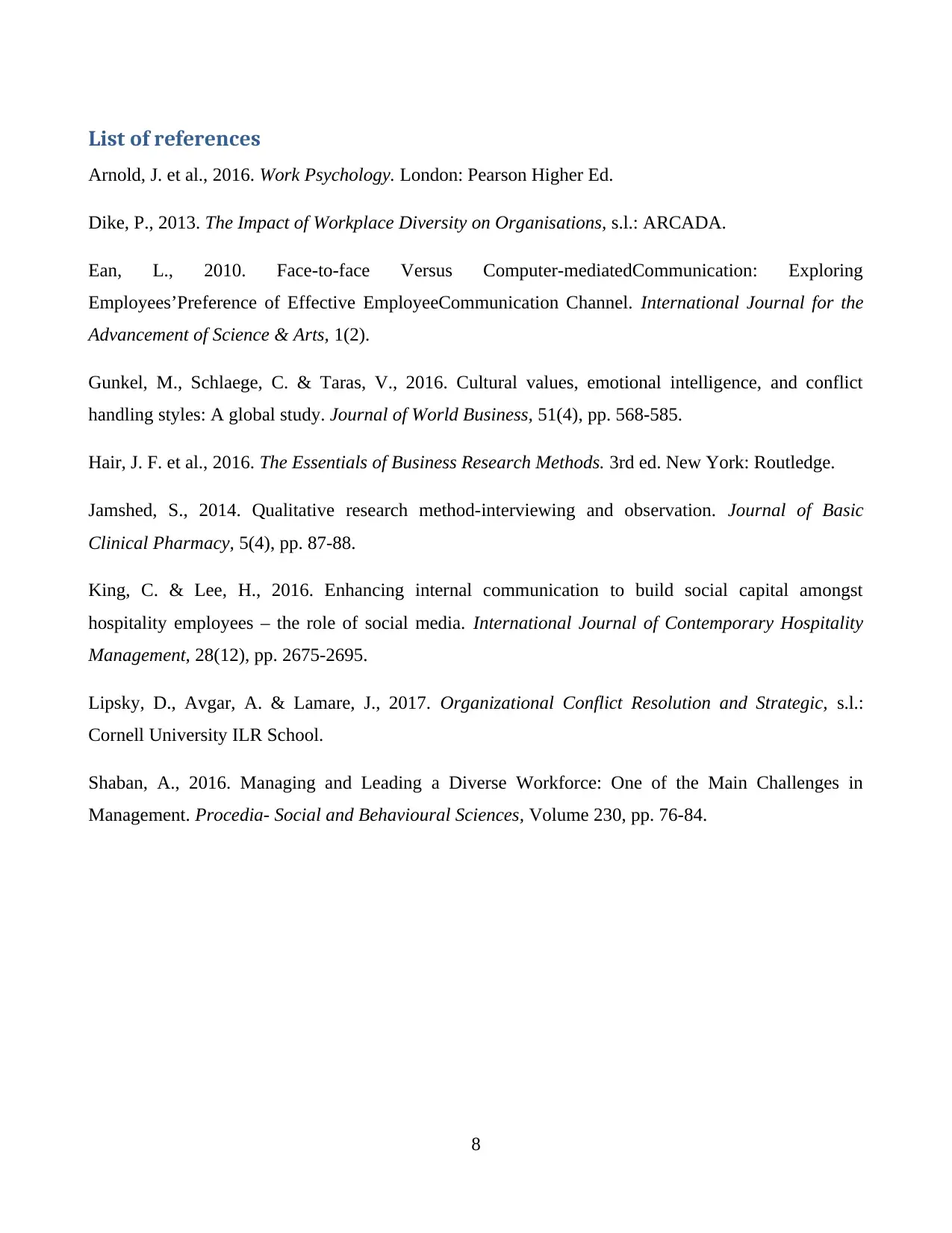
List of references
Arnold, J. et al., 2016. Work Psychology. London: Pearson Higher Ed.
Dike, P., 2013. The Impact of Workplace Diversity on Organisations, s.l.: ARCADA.
Ean, L., 2010. Face-to-face Versus Computer-mediatedCommunication: Exploring
Employees’Preference of Effective EmployeeCommunication Channel. International Journal for the
Advancement of Science & Arts, 1(2).
Gunkel, M., Schlaege, C. & Taras, V., 2016. Cultural values, emotional intelligence, and conflict
handling styles: A global study. Journal of World Business, 51(4), pp. 568-585.
Hair, J. F. et al., 2016. The Essentials of Business Research Methods. 3rd ed. New York: Routledge.
Jamshed, S., 2014. Qualitative research method-interviewing and observation. Journal of Basic
Clinical Pharmacy, 5(4), pp. 87-88.
King, C. & Lee, H., 2016. Enhancing internal communication to build social capital amongst
hospitality employees – the role of social media. International Journal of Contemporary Hospitality
Management, 28(12), pp. 2675-2695.
Lipsky, D., Avgar, A. & Lamare, J., 2017. Organizational Conflict Resolution and Strategic, s.l.:
Cornell University ILR School.
Shaban, A., 2016. Managing and Leading a Diverse Workforce: One of the Main Challenges in
Management. Procedia- Social and Behavioural Sciences, Volume 230, pp. 76-84.
8
Arnold, J. et al., 2016. Work Psychology. London: Pearson Higher Ed.
Dike, P., 2013. The Impact of Workplace Diversity on Organisations, s.l.: ARCADA.
Ean, L., 2010. Face-to-face Versus Computer-mediatedCommunication: Exploring
Employees’Preference of Effective EmployeeCommunication Channel. International Journal for the
Advancement of Science & Arts, 1(2).
Gunkel, M., Schlaege, C. & Taras, V., 2016. Cultural values, emotional intelligence, and conflict
handling styles: A global study. Journal of World Business, 51(4), pp. 568-585.
Hair, J. F. et al., 2016. The Essentials of Business Research Methods. 3rd ed. New York: Routledge.
Jamshed, S., 2014. Qualitative research method-interviewing and observation. Journal of Basic
Clinical Pharmacy, 5(4), pp. 87-88.
King, C. & Lee, H., 2016. Enhancing internal communication to build social capital amongst
hospitality employees – the role of social media. International Journal of Contemporary Hospitality
Management, 28(12), pp. 2675-2695.
Lipsky, D., Avgar, A. & Lamare, J., 2017. Organizational Conflict Resolution and Strategic, s.l.:
Cornell University ILR School.
Shaban, A., 2016. Managing and Leading a Diverse Workforce: One of the Main Challenges in
Management. Procedia- Social and Behavioural Sciences, Volume 230, pp. 76-84.
8
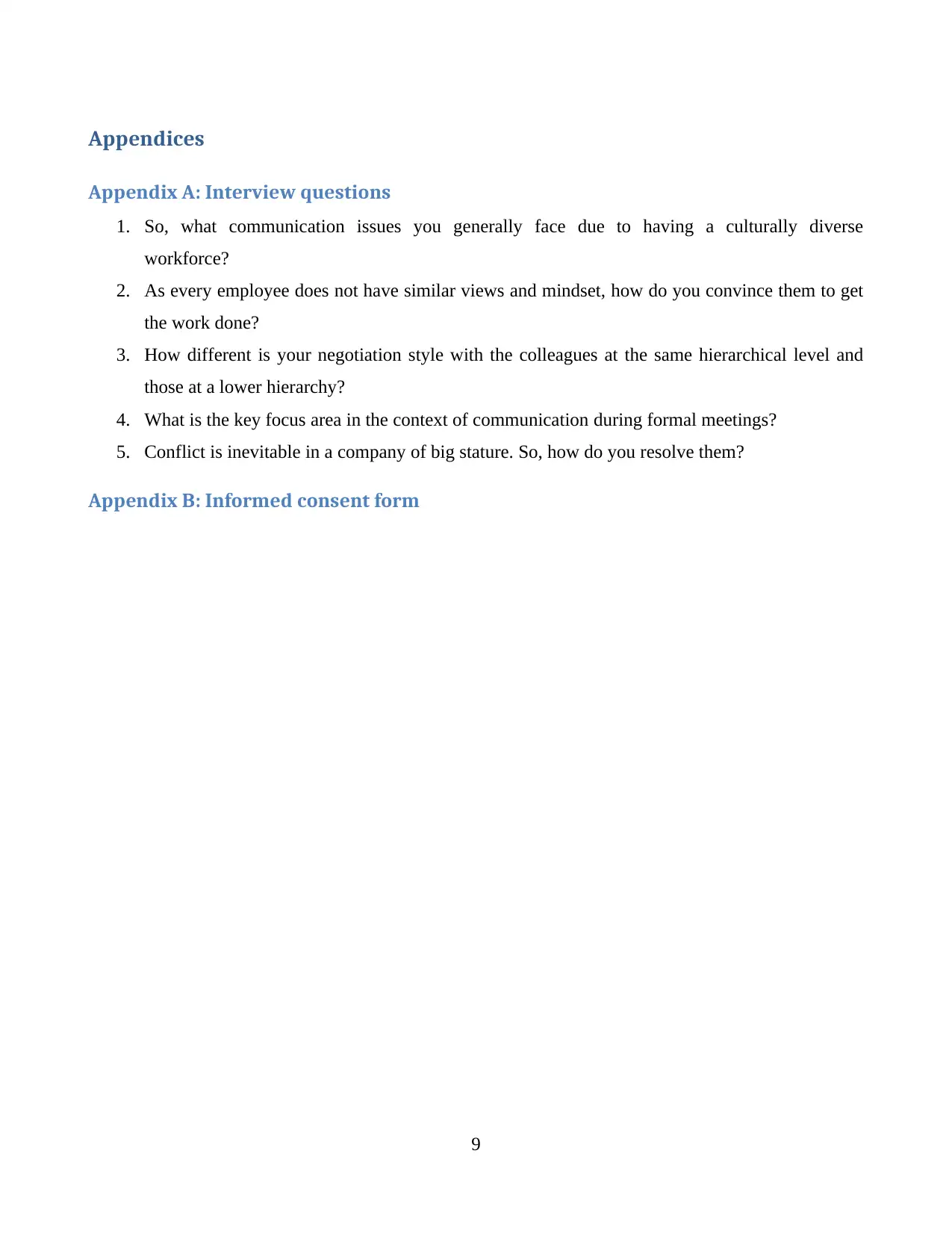
Appendices
Appendix A: Interview questions
1. So, what communication issues you generally face due to having a culturally diverse
workforce?
2. As every employee does not have similar views and mindset, how do you convince them to get
the work done?
3. How different is your negotiation style with the colleagues at the same hierarchical level and
those at a lower hierarchy?
4. What is the key focus area in the context of communication during formal meetings?
5. Conflict is inevitable in a company of big stature. So, how do you resolve them?
Appendix B: Informed consent form
9
Appendix A: Interview questions
1. So, what communication issues you generally face due to having a culturally diverse
workforce?
2. As every employee does not have similar views and mindset, how do you convince them to get
the work done?
3. How different is your negotiation style with the colleagues at the same hierarchical level and
those at a lower hierarchy?
4. What is the key focus area in the context of communication during formal meetings?
5. Conflict is inevitable in a company of big stature. So, how do you resolve them?
Appendix B: Informed consent form
9
⊘ This is a preview!⊘
Do you want full access?
Subscribe today to unlock all pages.

Trusted by 1+ million students worldwide
1 out of 9
Related Documents
Your All-in-One AI-Powered Toolkit for Academic Success.
+13062052269
info@desklib.com
Available 24*7 on WhatsApp / Email
![[object Object]](/_next/static/media/star-bottom.7253800d.svg)
Unlock your academic potential
Copyright © 2020–2025 A2Z Services. All Rights Reserved. Developed and managed by ZUCOL.




